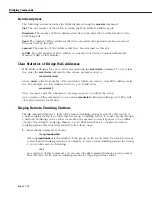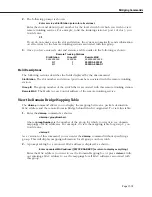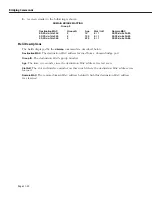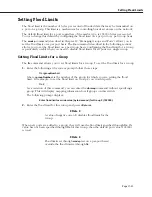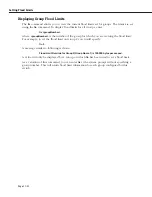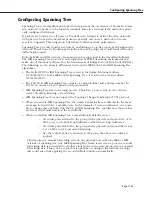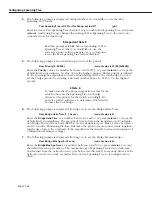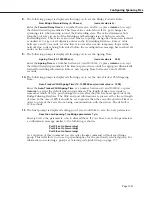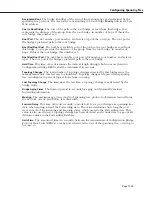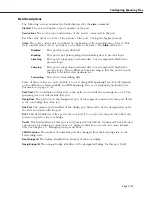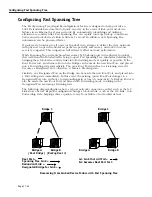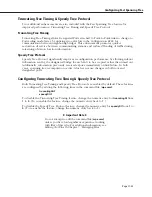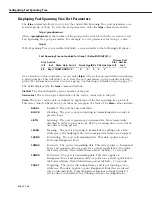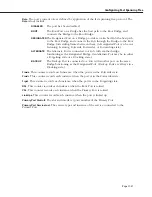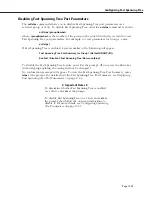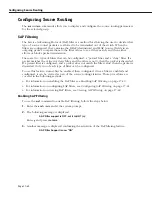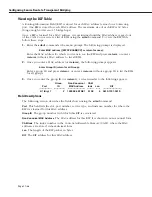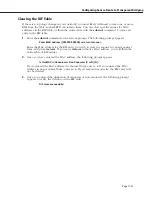
Configuring Spanning Tree
Page 17-32
Manual Mode
Allows you to manually set the state for each port (forwarding or blocking) or defer the port’s
state configuration to the spanning tree protocol, which will either be IEEE 802.1d or IBM.
This column is especially helpful if you are using the IBM Spanning Tree protocol with non-
Token Ring (e.g., FDDI or Ethernet) ports that do not support this IBM Spanning Tree. In this
situation you can manually set those ports to a forwarding (or blocking) state since the IBM
Spanning Tree protocol will not be able to control these ports. The possible settings for this
column are:
f
The port is in forwarding state and remains so unless you change it.
b
The port is in blocking state and remains so unless you change it.
n
The state of the port is determined by the IEEE 802.1d Spanning Tree
protocol. This option is not recommended because it means this Group
will have a hybrid spanning tree algorithm that mixes the IEEE 802.1d
and IBM Spanning Tree.
Displaying Spanning Tree Port Parameters
The
stps
command allows you to view the current spanning tree port parameters. To view the
port parameters, enter the
stps
command as shown:
stps <groupNumber>
where
<groupNumber>
is the number of the group in the switch for which you want to view
spanning tree port parameters. For example, to view parameters for Group 1, you would
enter:
stps 1
A screen similar to the following is shown:
Spanning Tree Port Summary for Group 1 (Default GROUP (#1))
Slot
Service
Path
Desig
Des
Rt
Swt
Fw
Root Bridge ID
Intf
Inst
Pri
State
MAC
Cost
Cost
Pt
Pt
Pt
Tx
Desig BridgeID
-----
----------
-----
-----------
-----------
------
-------
------
------
------
----
--------------------------------
3/1
Brg/ 1
128
FORWD
C473C4
10
10
No
Yes
No
0
0010-0020DA:81D5B0
8000-0020DA:0C41E1
As a variation to this command, you can enter
stps
at the system prompt without specifying a
group number. This will allow you to view the port parameters on the currently selected
group. For information on how to select a group, see
Selecting a Default Group
on page 17-7.
Summary of Contents for Omni Switch/Router
Page 1: ...Part No 060166 10 Rev C March 2005 Omni Switch Router User Manual Release 4 5 www alcatel com ...
Page 4: ...page iv ...
Page 110: ...WAN Modules Page 3 40 ...
Page 156: ...UI Table Filtering Using Search and Filter Commands Page 4 46 ...
Page 164: ...Using ZMODEM Page 5 8 ...
Page 186: ...Displaying and Setting the Swap State Page 6 22 ...
Page 202: ...Creating a New File System Page 7 16 ...
Page 270: ...Displaying Secure Access Entries in the MPM Log Page 10 14 ...
Page 430: ...OmniChannel Page 15 16 ...
Page 496: ...Configuring Source Route to Transparent Bridging Page 17 48 ...
Page 542: ...Dissimilar LAN Switching Capabilities Page 18 46 ...
Page 646: ...Application Example DHCP Policies Page 20 30 ...
Page 660: ...GMAP Page 21 14 ...
Page 710: ...Viewing the Virtual Interface of Multicast VLANs Page 23 16 ...
Page 722: ...Application Example 5 Page 24 12 ...
Page 788: ...Viewing UDP Relay Statistics Page 26 24 ...
Page 872: ...The WAN Port Software Menu Page 28 46 ...
Page 960: ...Deleting a PPP Entity Page 30 22 ...
Page 978: ...Displaying Link Status Page 31 18 ...
Page 988: ...Displaying ISDN Configuration Entry Status Page 32 10 ...
Page 1024: ...Backup Services Commands Page 34 14 ...
Page 1062: ...Diagnostic Test Cable Schematics Page 36 24 ...
Page 1072: ...Configuring a Switch with an MPX Page A 10 ...
Page 1086: ...Page B 14 ...
Page 1100: ...Page I 14 Index ...

